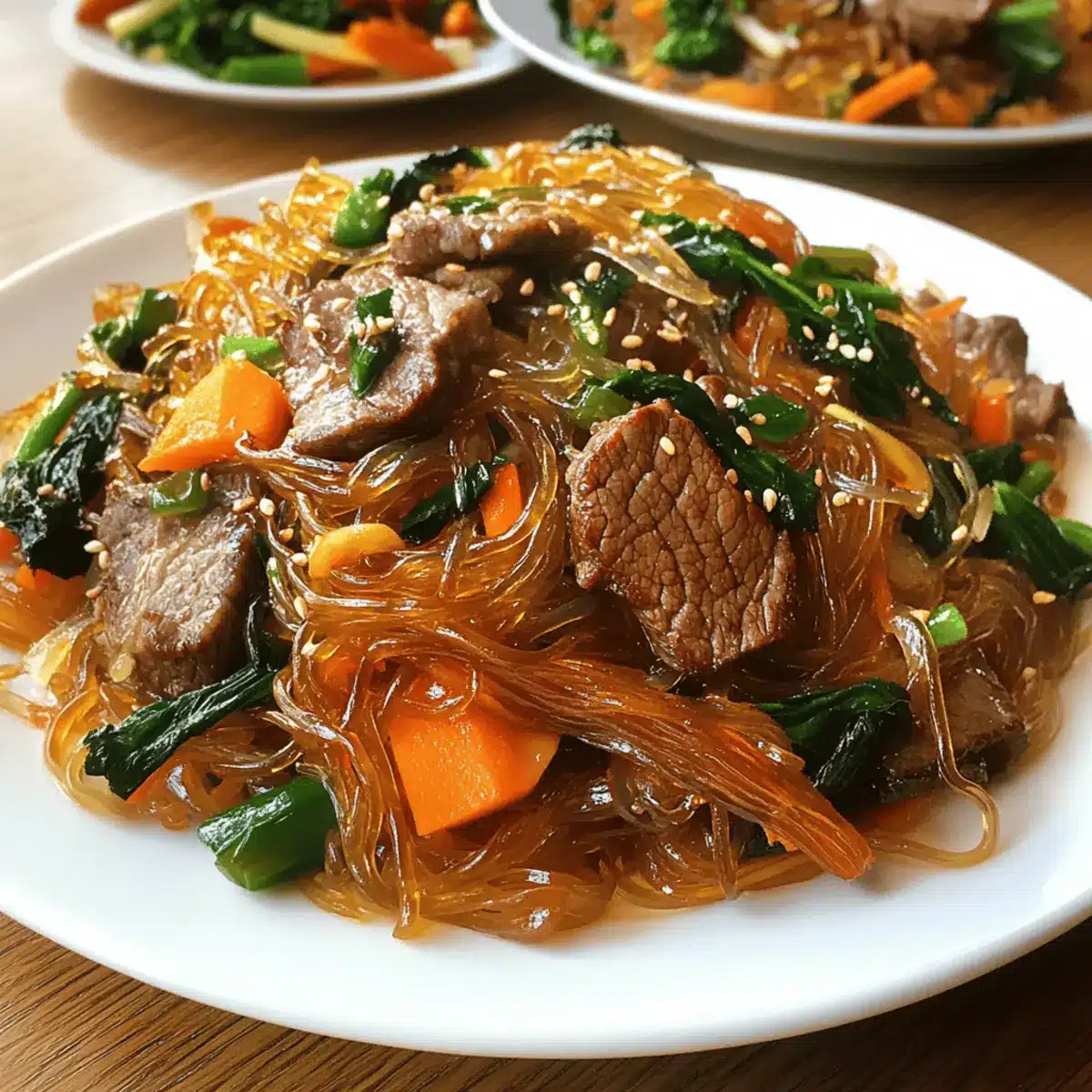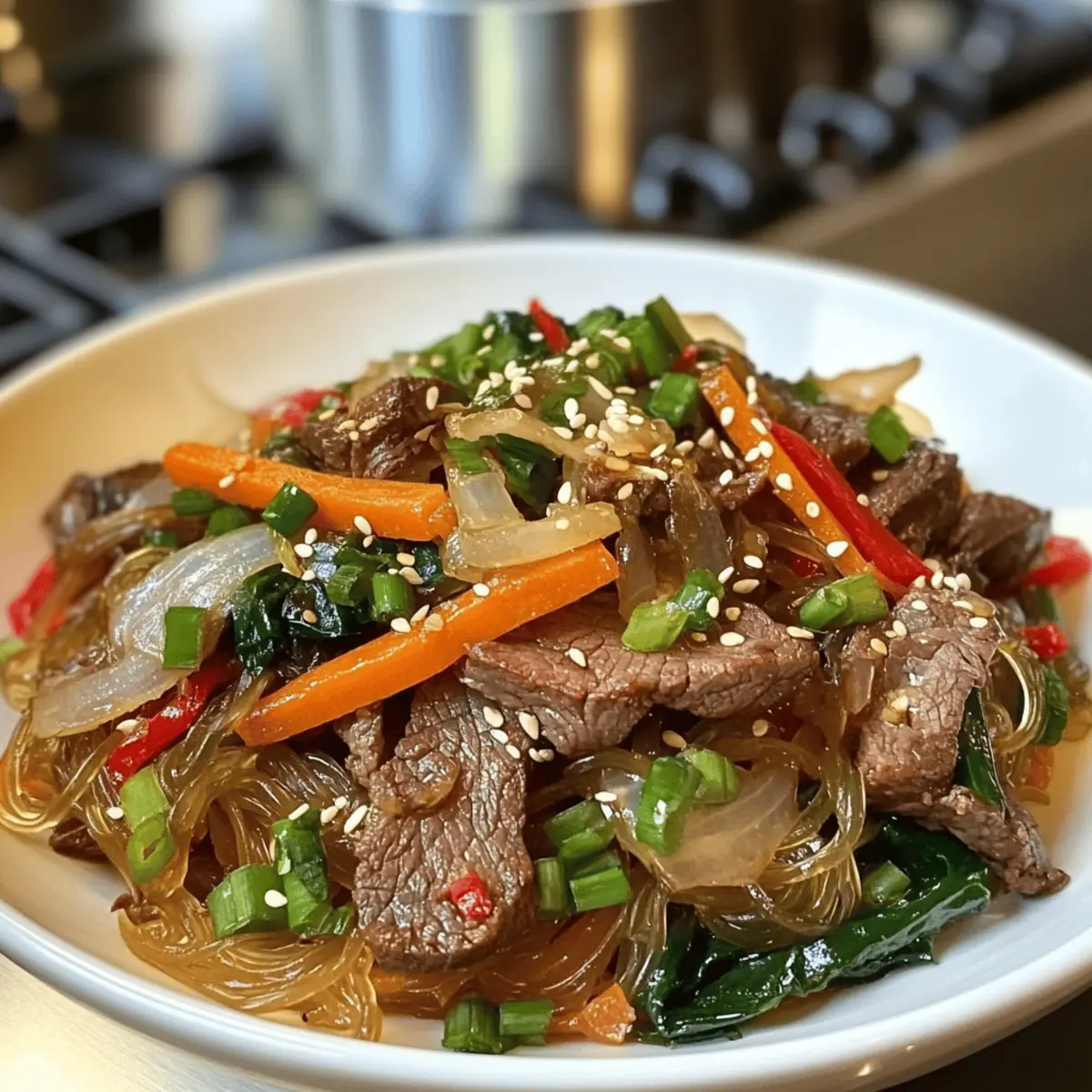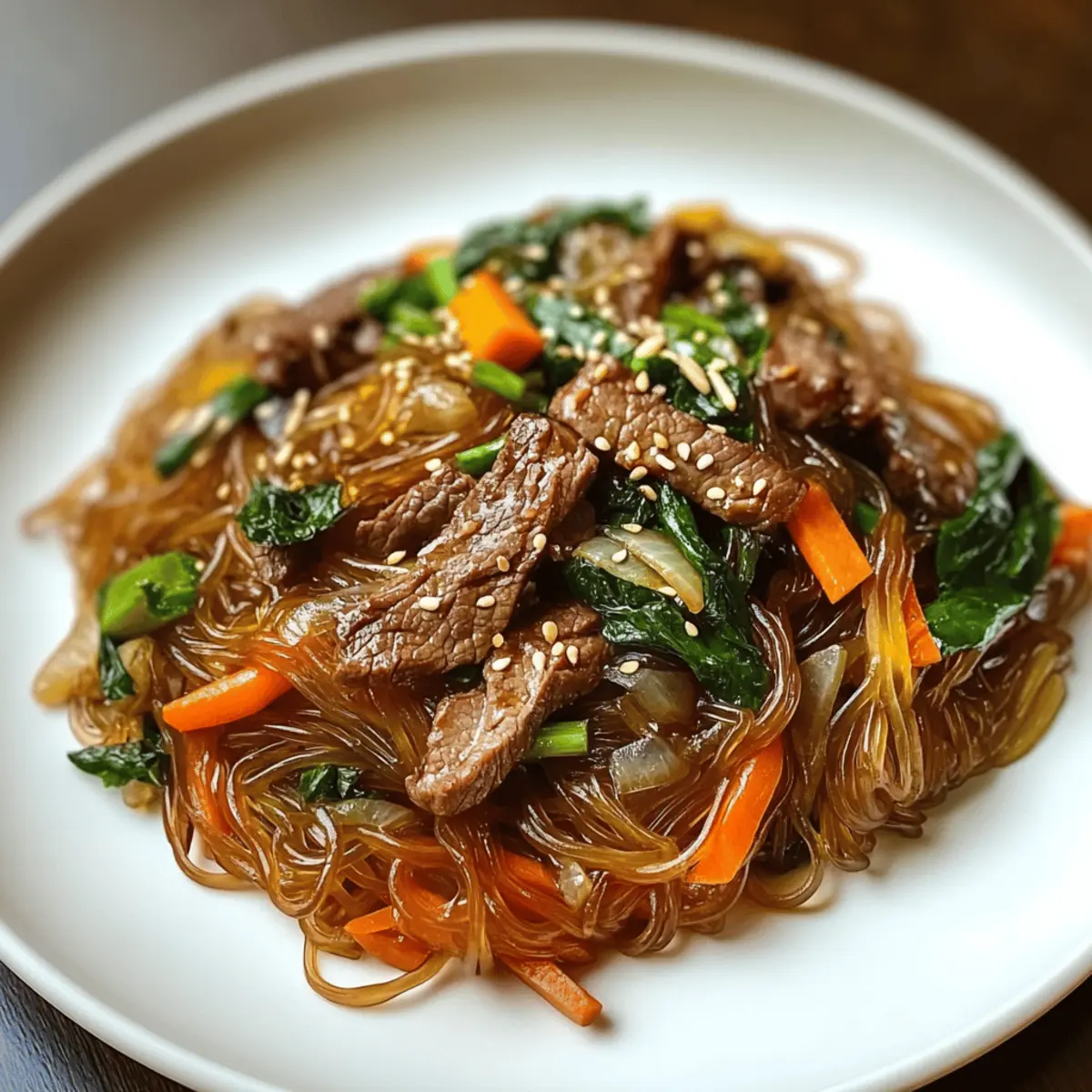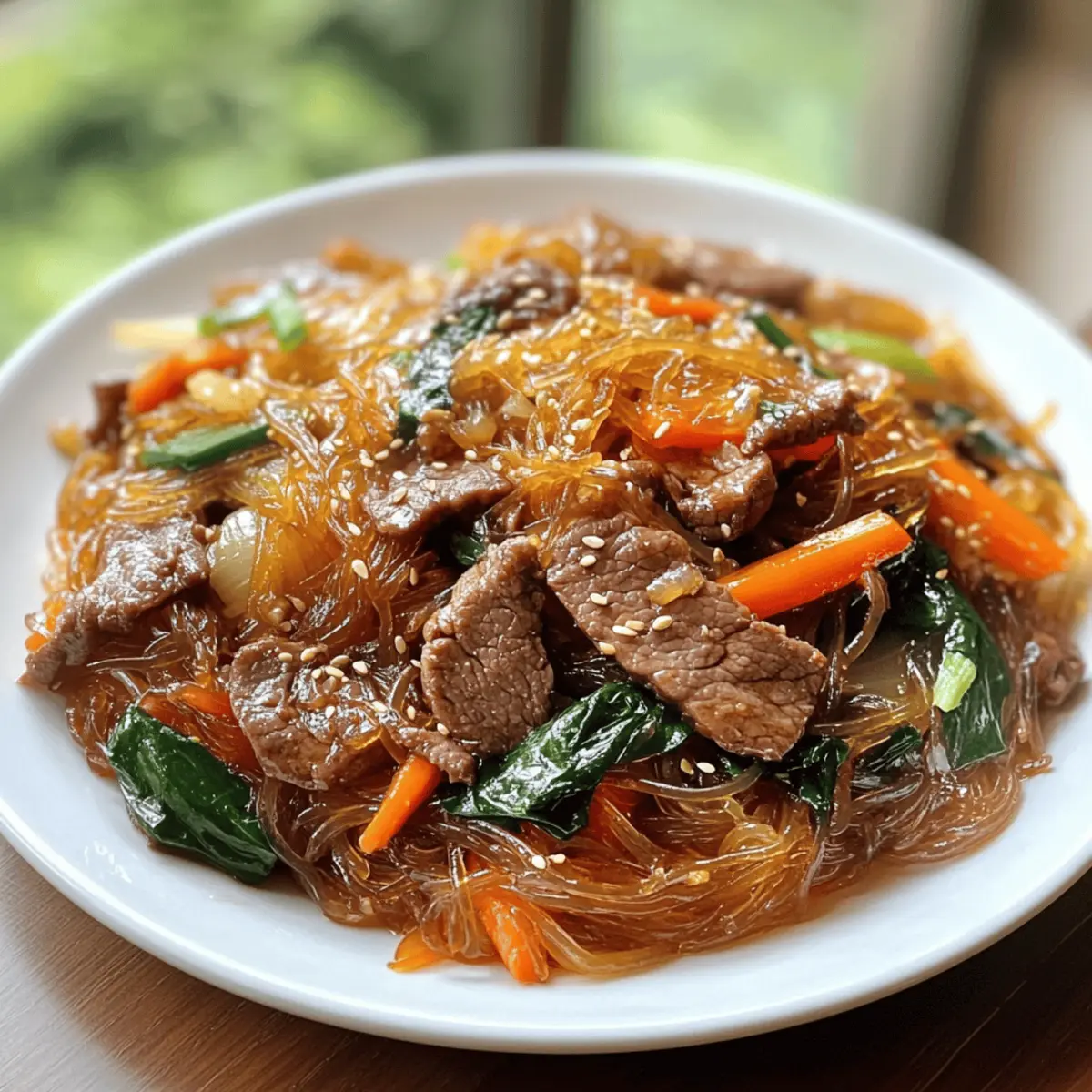As I gently stir the glossy strands of sweet potato glass noodles, the warm, nutty aroma of sesame oil envelops my kitchen, inviting a smile and sparking my imagination. This is the magic of Korean Japchae, a dish that effortlessly marries savory beef and vibrant vegetables, capturing the essence of comfort food with a touch of elegance. In just a few simple steps, you can whip up this delightful stir-fry that is not only customizable to suit your taste—whether you crave tender chicken, hearty tofu, or a spicy kick from gochujang—but also makes for a stunning centerpiece at any gathering or a cozy weeknight meal. Perfect for meal prep, this dish not only satisfies hunger but also brings a burst of color and personality to your table. Ready to transform your dinner into an extraordinary experience? Let’s dive into this vibrant world of flavors!

Why is Japchae a Must-Try?
Versatile Delight: Japchae’s beauty lies in its flexibility; whether you choose beef, chicken, or tofu, each variation bursts with flavor.
Healthy Ingredients: Packed with colorful veggies and gluten-free sweet potato noodles, it’s both nutritious and satisfying.
Quick to Prepare: Ready in under 30 minutes, Japchae is perfect for busy weeknights or impressing guests at special occasions.
Crowd-Pleasing Appeal: This dish’s vibrant colors and rich textures make it a showstopper at any gathering.
Meal Prep Friendly: Store leftovers for up to three days, ensuring delicious meals are always at your fingertips! Celebrate the culinary magic of this comforting dish and try pairing it with kimchi for an authentic Korean experience.
Korean Japchae Ingredients
• Dive into the flavors with these must-have ingredients for perfect Korean Japchae!
For the Noodles
- Sweet Potato Glass Noodles (Dangmyeon) – These chewy noodles form the heart of Japchae; if needed, you can substitute rice noodles for a different twist.
For the Protein
- Beef (or Chicken/Tofu) – Thinly sliced beef adds the perfect savory depth; chicken or tofu works wonderfully for lighter options.
For the Vegetables
- Carrots – They provide lovely color and a crunch that balances the dish beautifully.
- Spinach – Adds a pop of green and essential nutrients; feel free to replace it with other leafy greens.
- Bell Peppers – Their sweetness complements the dish; any color will do, so mix and match!
For the Sauce
- Soy Sauce – This adds the essential umami flavor; consider tamari for a gluten-free alternative!
- Sesame Oil – Infuses the dish with a rich, nutty essence, enhancing the overall taste.
For Garnish
- Green Onions – Sliced green onions brighten the dish and provide a fresh finish; chives can also be a delightful substitute.
Unleash the flavors of Korean Japchae by using these simple yet vibrant ingredients!
Step‑by‑Step Instructions for Korean Japchae
Step 1: Prepare Noodles
Cook the sweet potato glass noodles according to the package instructions, usually boiling them in water for about 6–8 minutes until they become transparent and tender. Drain the noodles in a colander, rinse them under cold water to prevent sticking, and set them aside while you prepare the other ingredients.
Step 2: Cook Beef/Protein
In a large skillet or wok, heat 1-2 tablespoons of oil over medium-high heat. Add the thinly sliced beef and stir-fry for about 3-4 minutes, or until browned and cooked through. Once done, remove the beef from the pan and set it aside, leaving any remaining oil, as it will flavor the vegetables.
Step 3: Stir-Fry Vegetables
In the same skillet, add a bit more oil if needed, and toss in the chopped carrots, bell peppers, and spinach. Stir-fry these colorful vegetables for about 3–5 minutes until they are tender yet still vibrant, maintaining a slight crunch. This step is crucial for ensuring your Korean Japchae has the perfect texture.
Step 4: Combine Ingredients
Once the vegetables are ready, return the cooked beef to the skillet. Add the prepared sweet potato glass noodles, then pour in 2-3 tablespoons of soy sauce and a drizzle of sesame oil. Toss everything together for about 2–3 minutes, ensuring the noodles are well coated and heated through while marrying the flavors beautifully.
Step 5: Finish and Serve
Allow the complete mixture to cook for an additional 1–2 minutes, making sure everything is thoroughly heated. For an extra touch, garnish with freshly sliced green onions just before serving. Your delicious Korean Japchae is now ready to be plated and enjoyed on its own or alongside your favorite rice or sides.

Expert Tips for Korean Japchae
- Perfect Noodle Texture: Rinse cooked noodles under cold water to prevent sticking; this ensures they remain chewy and not clumpy in your Korean Japchae.
- Veggie Crunch: Don’t overcook the vegetables! Aim for a tender but still crisp texture to add a delightful bite to your dish.
- Heat Management: Use a large enough pan to prevent overcrowding. This promotes even cooking and a beautiful stir-fry that keeps the vibrant colors intact.
- Protein Variations: Experiment with different proteins like chicken or tofu! Each adds its own unique flavor while making your Korean Japchae versatile.
- Spice it Up: If you love a bit of heat, a spoonful of gochujang or chili flakes can elevate flavors and bring a spicy kick to your dish.
- Serving Suggestions: Pair with kimchi for a traditional experience, or enjoy as a standalone dish—it’s just as delicious either way!
What to Serve with Classic Japchae?
Transform your dining experience with delightful pairings that elevate this colorful Korean noodle dish.
- Steamed Rice: The simplicity of steamed rice balances Japchae’s complex flavors, making each bite a comforting delight.
- Kimchi: This classic Korean side adds a spicy, tangy crunch that complements the sweetness of the noodles beautifully.
- Grilled Vegetables: Charred vegetables provide a smoky depth, enhancing the freshness of the stir-fry while adding a different texture.
- Pickled Radishes: These crisp, tangy bites cleanse the palate and add a refreshing contrast to the savory notes of the Japchae.
For a lovely finish, consider serving Mango Sticky Rice. Its creamy sweetness pairs wonderfully with the savory flavors of the noodles, rounding out your meal with a touch of tropical bliss. Another fantastic option is Chilled Soba Noodles drizzled with sesame sauce, offering a cool, nutty touch that complements the warm, savory stir-fry perfectly. Enjoy crafting your perfect meal around this delightful Korean Japchae!
How to Store and Freeze Korean Japchae
Fridge: Store leftover Korean Japchae in an airtight container in the refrigerator for up to 3 days to maintain freshness and flavor.
Freezer: For longer storage, freeze Korean Japchae in a freezer-safe container for up to 2 months. Make sure it’s properly sealed to prevent freezer burn.
Reheating: When ready to enjoy, thaw overnight in the fridge, then reheat gently on the stovetop or in the microwave until warmed through.
Servings: If preparing for a gathering, consider doubling the recipe, as this dish stores well and tastes delightful even the next day!
Korean Japchae Variations & Substitutions
Feel free to let your creativity shine and personalize this dish to suit your taste buds!
-
Vegetarian Option: Substitute beef with tofu for a meat-free version that still delivers on protein and flavor.
Feel the satisfaction of a hearty meal without the meat. Tofu absorbs the delicious sauce, enhancing the overall taste! -
Gluten-Free: Use tamari instead of soy sauce to keep the dish gluten-free without sacrificing flavor.
Your Japanese-inspired feast can include everyone at the table, gluten-free friends included! -
Spicy Kick: Add a spoonful of gochujang or chili flakes to the vegetables for a flavorful heat boost.
A little spice can go a long way, transforming your japchae into a zesty adventure! -
Seasonal Vegetables: Use seasonal veggies like zucchini or snap peas for fresh, vibrant bites.
Change it up and embrace what’s in season—each fresh ingredient will bring its unique character to the dish! -
Crispy Texture: Top your japchae with toasted sesame seeds or crushed peanuts for an added crunch.
The contrast of textures from the crunchy topping makes every bite all the more delightful! -
Noodle Alternatives: Swap sweet potato glass noodles for zucchini noodles for a lighter, low-carb version.
Enjoy the same satisfying stir-fry experience while making it a bit more veggie-packed! -
Silken Tofu: Incorporate silken tofu cubes at the end of cooking for a creamy twist to your dish.
This adaptation will not only add creaminess but ups the nutrition factor as well! -
Bold Flavors: Incorporate sliced mushrooms or kimchi into the stir-fry for an additional depth of flavor.
These ingredients add umami richness that beautifully complements the cozy taste of Japchae.
Mix and match these variations to create your perfect bowl of Korean Japchae! To explore more options, you might enjoy checking out plant-based meals or discovering the world of international flavors to inspire your culinary journey.
Make Ahead Options
Japchae is a fantastic choice for meal prep, ideal for busy home cooks looking to save time during the week! You can prepare the sweet potato glass noodles and vegetables up to 24 hours in advance. Simply cook the noodles according to the package instructions, rinse them under cold water to prevent sticking, and store them in an airtight container. The chopped vegetables can also be prepped and refrigerated in a separate container, ensuring they retain their crunch. When you’re ready to serve, just stir-fry everything together with the cooked protein and sauce for a quick meal that’s just as delicious as when freshly made. Enjoy the convenience of Japchae while keeping your flavors vibrant and textures perfect!

Korean Japchae Recipe FAQs
What kind of noodles should I use for Korean Japchae?
Absolutely! For authentic Korean Japchae, you should use sweet potato glass noodles, known as dangmyeon, as they provide the signature chewy texture. If you can’t find them, rice noodles can be a suitable substitute, though the texture will differ slightly. Ensure to follow the cooking times on the package for best results.
How can I store leftovers of Korean Japchae?
You can store leftover Korean Japchae in an airtight container in the refrigerator for up to 3 days. Make sure to let the dish cool to room temperature before sealing it. This way, you can enjoy a delicious meal without compromising on flavor!
Can I freeze Korean Japchae? How?
Yes, you can definitely freeze Korean Japchae! Allow it to cool completely, then transfer it into a freezer-safe container. Be sure to remove as much air as possible to prevent freezer burn. It can be frozen for up to 2 months. When ready to eat, simply thaw it overnight in the fridge and reheat it gently on the stovetop or in the microwave.
What if my noodles stick together when cooking?
If your noodles become sticky, don’t worry! To prevent this from happening, rinse your sweet potato glass noodles in cold water immediately after cooking. This helps stop the cooking process and removes excess starch. Also, using a large pan while stir-frying allows for better circulation and reduces the chance of sticking.
Are there any dietary considerations with Korean Japchae?
Great question! Korean Japchae is naturally gluten-free when using soy sauce alternatives like tamari. For those with allergies or dietary restrictions, opt for chicken or tofu instead of beef, and always double-check the labels of your sauces for additives. This dish can be enjoyed by everyone with a few thoughtful swaps!

Delicious Korean Japchae: Your Must-Try Noodle Delight
Ingredients
Equipment
Method
- Cook the sweet potato glass noodles according to package instructions, about 6-8 minutes until transparent and tender. Drain and rinse under cold water.
- In a large skillet, heat 1-2 tablespoons of oil over medium-high heat. Stir-fry the thinly sliced beef for 3-4 minutes until browned.
- In the same skillet, add more oil if needed and stir-fry the chopped carrots, bell peppers, and spinach for 3-5 minutes until tender.
- Return the cooked beef to the skillet, add the noodles, soy sauce, and sesame oil. Toss for 2-3 minutes until well coated.
- Cook for an additional 1-2 minutes and garnish with green onions before serving.

Leave a Reply